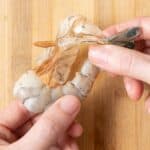How to Peel Shrimp
Discover two easy ways to peel and devein shrimp: by hand or with kitchen shears. They will be ready to add to any recipe!
Servings 4 servings
Calories 81kcal
Ingredients
- 1 pound Raw shrimp with shell on any size
Instructions
- Peel the shrimp with your hands: Use your thumbs to crack the shrimp shell and then peel it away from the shrimp and discard.
- Peel the shrimp with kitchen shears: Alternatively, use kitchen shears to carefully make a cut at the top of the shrimp along its length until you reach the tail. Peel the shell away from the shrimp and discard.
- You can keep the tail on for cooking, or if you prefer to remove it, pinch the tail at the end of the shrimp body where it starts to feel hollow and gently pull to separate the tail from the rest of the shrimp.
- Use a sharp paring knife or your fingers to make a shallow cut along the back of the shrimp, being careful not to cut too deeply.
- Use the tip of the knife or your fingers to pull out the vein (it will look like a long black and gritty string), which runs along the back of the shrimp.
- Rinse the shrimp under cold running water to remove any remaining debris. Then use as desired.
Video
Notes
Storage: Store raw peeled shrimp in an airtight container in the refrigerator for up to 2 days.
Freezing: To freeze, first flash freeze by laying the peeled shrimp on a baking sheet in a single layer and freeze until solid. Once frozen, transfer them to a sealed freezer bag, removing as much air as possible to prevent freezer burn. Flash freezing will prevent the shrimp from sticking to each other. Thaw overnight in the fridge and use as desired in recipes.
Tips:
Start with chilled shrimp. Place the shrimp in the freezer for 15-20 minutes before peeling. This slight chill makes the shells firmer and easier to handle.
Keep a bowl of water close by. Having a bowl of cold water nearby to rinse your hands keeps your hands clean and free from sticky shrimp shells or other residue.
Practice mise en place. This is a French term that refers to having all of your tools prepared for efficient workflow. This includes a bowl for discarded shells, kitchen shears, bowl of cold water for rinsing, a small knife, and a designated space for peeling.
Keep the tails on. Leaving the tail on the shrimp prevents them from drying out during cooking. This is especially helpful when cooking shrimp in dry heat methods such as grilling.
Nutrition
Serving: 4ounces | Calories: 81kcal | Carbohydrates: 1g | Protein: 15g | Fat: 1g | Saturated Fat: 0.1g | Polyunsaturated Fat: 0.1g | Monounsaturated Fat: 0.1g | Trans Fat: 0.01g | Cholesterol: 143mg | Sodium: 642mg | Potassium: 128mg | Vitamin A: 204IU | Calcium: 61mg | Iron: 0.2mg
